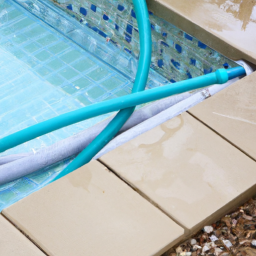How To Drain Inground Pool With Garden Hose
Table of Contents []
How To Drain Inground Pool With Garden Hose
Introduction
Are you looking for a step-by-step guide to understanding how to drain an inground pool with a garden hose? If so, you're in the right place! In this article, we'll look at the 8-12 topics you need to know in order to be able to drain an inground pool correctly with a garden hose. We cover the different tools you'll need, the safety precautions to take, and the different steps involved. We'll also look at some popular subtopics to provide a deeper understanding, such as the types of pumps to use, the problems you may encounter, and how to properly clean and store your supplies after draining your pool. After reading this article, you'll have all the information you need to take proper actions and prepare a successful draining of your pool.
Tools Needed
The first step in draining a pool with your garden hose is preparing the necessary tools. To start, you will need a garden hose that is at least 50 feet long. It's important to make sure this hose is designed for outdoor usage; thin, plastic hoses meant for indoor use will not suffice. In addition, you will need a filter pump, a water hose, and a bucket. Make sure the filter pump is powerful enough to take on the amount of water in your pool.
Safety Precautions
You should always keep safety in mind whenever you are draining a pool. First, you should turn off the power to the pool before draining to ensure your safety. Make sure to check the filter, as well, and ensure that it is disconnected from power sources once the power is shut off.
Preparing Pool
Once the necessary tools are gathered and safety precautions are taken, the next step is to prepare the pool for draining. This includes removing the skimmer baskets, ladders, and any other accessories around the pool. You should also check for any nearby power sources, such as power lines, to ensure that the job can be done safely.
Connecting Garden Hose
Once the pool is fully prepared, the next step is to connect the garden hose to the filter pump. This part of the process requires you to make sure the hose is properly placed and secured in the pump. Once the hose is properly attached to the filter, you can turn the power back on to the pump.
Draining Pool
Now that the garden hose is securely attached to the filter pump and power is on, you are ready to begin draining the pool. Start the pump and allow the water to begin flowing out of the hose at a safe speed. You must be careful to not allow the hose to kink, as this will cause the pressure and flow to decrease, resulting in the draining process taking longer. If you notice the flow decreasing, stop the pump and check the hose for any possible kinks or blockages.
Popular Subtopics
Types of Pumps
Now that you know the basics of draining an inground pool with a garden hose, let's delve a bit deeper and look at the different types of pumps available. Centrifugal pumps are the most common type used in pool draining and are suitable for medium flows. Submersible pumps, on the other hand, are appropriate for pools with low flow rates while Positive Displacement pumps are suitable for pools with higher flow rates.
Problems you May Encounter
There are a few problems you may encounter when trying to drain your pool. These include clogging due to various sources, pool water backing up, and water pressure irregularities. Clogging is the most common issue and can be solved by regular maintenance to ensure debris doesn't accumulate in the hose. Pool water backing up is caused by air pressure differences and can be avoided by keeping the pump running for an extra minute or two to ensure no air is left in the line. Water pressure irregularities can be solved by increasing the pump flow rate.
Cleaning and Storing Supplies
Once the pool is drained, the final step is to clean and store your supplies. Before you put away the pump, make sure to drain out any remaining water and clean the filter to prevent any build-up of debris or dirt. Put everything away properly and in a dry place make sure to not leave the filter outdoors as this can cause damages to it.
Conclusion
Knowing how to drain an inground pool with a garden hose is an important skill to have when it comes to maintaining your pool. With the right tools, safety precautions, and steps, you'll be able to quickly and efficiently drain your pool. Make sure to follow the steps in this article and look at the subtopics we've covered for a more in-depth knowledge and successful outcome!

Previous Page
Next Page
